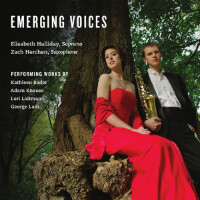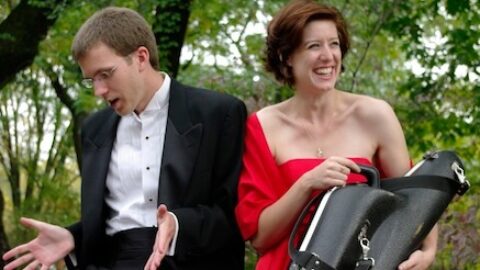While there is perhaps an over-abundance of saxophonists capable of playing blaring high notes, blazing fast runs, and numerous other technical feats, there are few who have attempted to attain the more difficult accomplishment of blending with other instruments, let alone the human voice, with sensitivity and taste. Entering this abyss is saxophonist Zach Herchen, who has teamed up with soprano Elisabeth Halliday to create Emerging Voices. They commissioned three brand new pieces for their new CD, and included their inspiration for the sax / voice duo, Lori Laitman’s I Never Saw Another Butterfly. The naked combination of saxophone and soprano proves a success, creating excellent moments of blend and dialogue. I never felt like the pieces lacked an anchor despite the lack of a harmonic instrument.

Laitman’s I Never Saw Another Butterfly, composed in 1998, is one of the first substantial pieces to brave the sax / voice duo. Its text is drawn from poems by children of the holocaust, and alternates between the horrors that surrounded them as well as the few joys that these children were able to find amidst the sorrow. Its six short movements range from depressed elegy to bouncy and dance-like to ominous pulsation. I was impressed with how well Herchen and Halliday brought out the different qualities and moods of each movement. The last movement, “The Old House,” particularly stood out for the barren, “deserted” beginning, with the saxophone starting from nothing and the voice feeling somber and lonely. Both performers demonstrated a good deal of restraint, waiting until the big moments to burst with more untamed expressivity. Herchen in particular employed a lot of pure tone, holding back the vibrato for the right moments. His solid rhythmic accompaniment, especially during moments of bouncy grace-note figures or accented pulsation, did well to provide a backbone over which Halliday could capture the text. On other movements, Herchen’s haunting tone and Halliday’s brooding sound were the right musical imagery for the horrific subject matter.
Kathleen Bader’s Two Songs for the Sounds Outside churns through different emotional reactions. Its text personifies objects from nature, and Halliday excels at putting herself in the position of the emotional observer and narrator in the way she shapes phrases and shades notes, and she handles the leaps into her upper register with finesse. Herchen’s tone here is mostly well-rounded and subtle, blending nicely with Halliday’s voice and engaging successfully in musical imitation. The sudden chromatic descent in the saxophone and concurrent frantic vocal part was a particularly treat in the first movement. In the second movement, I was impressed with the strong sense of meter, pulse, and horizontal motion. On this and every other track, Halliday brought a sense of character and drama to her voice that truly imbued the texts.
 George Lam’s The Person in the Room Wishes to be Left Alone seemed to embrace the barren instrumentation. Starting with slow, somewhat eerie trills in the saxophone, it creates atmospheric moods with minimal materials and moves to varying intensities in the vocal part. A tasteful use of background noises—typewriter and ocean sounds—added to the eerie quality of this piece. The arc form provided a nice sense of unity and cohesion, with the material from the beginning returning at the conclusion. Overall this was a good use a few solid musical elements by Lam to create something still rich in subtleties and enticing throughout.
George Lam’s The Person in the Room Wishes to be Left Alone seemed to embrace the barren instrumentation. Starting with slow, somewhat eerie trills in the saxophone, it creates atmospheric moods with minimal materials and moves to varying intensities in the vocal part. A tasteful use of background noises—typewriter and ocean sounds—added to the eerie quality of this piece. The arc form provided a nice sense of unity and cohesion, with the material from the beginning returning at the conclusion. Overall this was a good use a few solid musical elements by Lam to create something still rich in subtleties and enticing throughout.
Portrait by Adam Knauss takes its text from James Joyce’s A Portrait of the Artist as a Young Man. Somehow Knauss managed to succeed in turning the stream-of-consciousness style writing into a coherent musical work without losing the sense of spontaneity. Not only that, but he put musical accents and a good sense of flow into the text and sectioned it into different musical contexts. The saxophone often plays steady, flowing, calm material, providing a solid anchor for the voice. I especially enjoyed the moment at which the saxophone darted in and out of the vocal parts, filling in spaces and punctuating phrases. While there was a lot of text to get through, Knauss nevertheless found moments to indulge in lyricism or craziness, and I was especially impressed with an off-kilter venture for the saxophone.
On the whole I think this disc is a great success at putting the saxophone and soprano voice together, and will hopefully influence saxophonists to put greater attention to beauty and blend. The timbres and phrasing of both Herchen and Halliday reflect a lot of hard work and contemplation, and the composers likewise have molded their music to the unique qualities of this duo.
Emerging Voices can be purchased at http://www.zachherchen.com/store/.
Check some upcoming performances.
–-
David Pearson is a saxophonist residing in NYC and a doctoral candidate in musicology at CUNY Graduate Center.
























